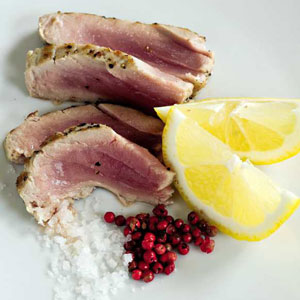Fresh tuna looks and grills like steak, only much quicker and, some
would say, it is much tastier (and of course healthier; tuna is packed
with protein, omega 3 fatty acids and a good dose of selenium).
Although it’s an oily fish, fresh tuna has only one percent fat per
body weight, so it’s fine for those trying to slim down.
Scroll down for 10 delicious recipes using fresh tuna.
Background
The word ‘tuna’ dates back to 1880 in print and is said to be
a Spanish/American derivation of the English word tunny. Tuna is a
member of the mackerel family and has a more robust flavour than
whitefish. The enormous Bluefin tuna has dark red flesh and coveted by
the Japanese for thei sushi and sashimi. Yellow fin tuna (also known as
Ahi) is less expensive than Bluefin and more easily found, though some
argue it’s flavour is better than that of the Bluefin.
Skipjack tuna, also known as Bonito or by it’s Hawaiian name, Aku,
is a small, dark-fleshed fish, used for canning and in Japanese
cuisine. Finally, Albacore tuna, the only white-fleshed tuna, sometimes
marketed as ‘chicken of the sea’, is preferred above all others for
canning.
Usage
Like all oily fish, tuna should be eaten as fresh as possible and
handled with the utmost care to prevent the delicate meat from bruising
and going to a pulp. Because the Bluefin is so large, the quality of
meat can vary depending on what part of the fish it comes from. The
belly, the oiliest section of the fish, is prized by the Japanese for
sashimi while the red meat along the backbone is the leanest. Except
for tuna steaks, the skin of this delicious fish is generally removed
before cooking.
The best tuna steaks look much like raw beef, but don’t go for
steaks that have dry or brown spots, a ‘rainbow’ sheen or don’t smell
absolutely ocean-fresh. Use fresh tuna on the day that you buy it, but
if this isn’t possible, pat it dry, wrap securely in plastic wrap or
foil and store in the coldest part of your fridge or on a bed of ice,
and use within 24 hours.
For centuries tuna has been the main ingredient of a host of
different dishes the world over. And it’s not only the Japanese that
like it raw: the French like to marinate it in a fennel vinaigrette for
a couple of hours before tucking in. In fact, the texture of raw tuna,
tender with no trace of pulpiness, is perfect for slicing very fresh
and marinating in lemon or lime, olive oil and a touch of chilli
pepper. It should marinate for 1 to 2 hours. When eaten raw with any
manner of flavourings, the dish would often be called tuna tartare, so
look out for it on menus.
Tuna’s firm, meaty texture makes it an excellent choice for braaing;
simply marinate with garlic and soy sauce for an hour and pop on to the
grill, literally cooking it one to two minutes a side to prevent the
meat from drying out. If it’s still a bit raw in the middle, so be it.
A word of warning: tough, dry, grilled tuna is no delight, especially
considering how tender, moist, and meaty it can be if prepared and
grilled right. Because tuna lacks the natural fat that makes grilled
salmon so moist and delectable, it’s easy to dry out its flesh and
intensify its rich flavour to the point of near-overwhelming fishiness.
Properly cooked over the coals, tuna will be seared and crusty on the
outside and rare and pink on the inside.
Fresh tuna chunks also make wonderful kebabs, and are especially
good flavoured with sage. That said, braised tuna is a classic dish,
the French would even lard the fish with bacon or anchovies for added
depth of flavour. Or they’d make a tuna stew with potatoes, peppers and
tomatoes. Yummy.
10 Tuna recipes
1. Tuna pasta
2. Tuna pizza
3. Tuna rice salad
4. Baked potatoes with tomato and tuna filling
5. Fresh tuna wrapped in rice paper
6. Chargrilled tuna with coriander pesto

